You are using an out of date browser. It may not display this or other websites correctly.
You should upgrade or use an alternative browser.
You should upgrade or use an alternative browser.
Export thread
Rebuild or replace with a new or rebuilt short block? Who has the best deal?
#1

turbofiat124
turbofiat124
This is one of those "DUH" things. I overfilled my 6 year old 21hp Intek engine during my last oil change. Got distracted, didn't really realize it at the moment. Thought the engine would just burn any excess oil out of the engine and that would be the end of it. Well apparently not.
Now it's burning oil all the time. Fresh oil immediately turns black as coal. Yesterday I was mulching leaves and the engine started to sputter. I pulled the spark plug and it was coked up with ash deposits from where it's burning so much oil. Gave it a good bead blasting in my cabinet and mulched some more.
Apparently overfilling the engine with oil will damage the rings. According to a guy I work with who works on lawnmowers.
I'm hoping I can keep enough "used" oil in this engine to prevent it from seizing up until I can finish mulching up these leaves. Then repair the engine this winter.
Question:
I have not talked to my co-worker to see how much it would cost to fix this engine.
I am mechanically inclined but out of all the things I've done with cars and mowers, I have never actually installed new rings in an engine. Other than putting together rebuilt short blocks and cylinder heads in cars and dropping them in.
I'm not sure if that's all it would take to control the oil burning. Did I screw up the valve seals along with it?
Any chance I just messed up the PVC system and that might be why it's burning oil? I know that there is a diaphragm inside the PVC box on the side of the engine and if it goes bad, it will such oil into the breather and blow oil all over the engine (seen it happen on a Tecumseh) but not sure if that would cause the engine to burn oil. I suppose I could look in the breather and see if I see any excess oil.
Or is that wishful thinking?
Now might be a good opportunity to learn how to install new rings in an engine! But my time is limited.
My idea would be to buy a new short block and transfer all the bits from my old engine over to it myself. Or tear the engine down to the short block and take it to him and have him install new rings or whatever else it needs. To save some money.
Can I even buy a remanufactured short block with or without a core charge?
I'm trying to weigh the cost of someone else's labor versus new parts.
What's my best option?
I don't have the model number handy but it's a 21hp Intek vertical shaft engine. Who has the best deals on shortblocks?
What are some of my other options? Or than buying a used engine?
I actually have a good 15 HP Kolher engine that is on an old Snapper with a seized transmission but don't think it would have the balls to turn the blades on a mower with a 48" dual blade deck.
I tried replacing a seized Briggs 11, 12 or 13 HP (can't remember) engine on an old 1979 Snapper with an 8HP Tecumseh engine and if the grass was more than 6" high, it would stall the engine. So I think the same thing would happen with this Craftsman mower if I drooped down from a 21 to a 15 HP engine. I'm not sure if I want to go that route.
Now it's burning oil all the time. Fresh oil immediately turns black as coal. Yesterday I was mulching leaves and the engine started to sputter. I pulled the spark plug and it was coked up with ash deposits from where it's burning so much oil. Gave it a good bead blasting in my cabinet and mulched some more.
Apparently overfilling the engine with oil will damage the rings. According to a guy I work with who works on lawnmowers.
I'm hoping I can keep enough "used" oil in this engine to prevent it from seizing up until I can finish mulching up these leaves. Then repair the engine this winter.
Question:
I have not talked to my co-worker to see how much it would cost to fix this engine.
I am mechanically inclined but out of all the things I've done with cars and mowers, I have never actually installed new rings in an engine. Other than putting together rebuilt short blocks and cylinder heads in cars and dropping them in.
I'm not sure if that's all it would take to control the oil burning. Did I screw up the valve seals along with it?
Any chance I just messed up the PVC system and that might be why it's burning oil? I know that there is a diaphragm inside the PVC box on the side of the engine and if it goes bad, it will such oil into the breather and blow oil all over the engine (seen it happen on a Tecumseh) but not sure if that would cause the engine to burn oil. I suppose I could look in the breather and see if I see any excess oil.
Or is that wishful thinking?
Now might be a good opportunity to learn how to install new rings in an engine! But my time is limited.
My idea would be to buy a new short block and transfer all the bits from my old engine over to it myself. Or tear the engine down to the short block and take it to him and have him install new rings or whatever else it needs. To save some money.
Can I even buy a remanufactured short block with or without a core charge?
I'm trying to weigh the cost of someone else's labor versus new parts.
What's my best option?
I don't have the model number handy but it's a 21hp Intek vertical shaft engine. Who has the best deals on shortblocks?
What are some of my other options? Or than buying a used engine?
I actually have a good 15 HP Kolher engine that is on an old Snapper with a seized transmission but don't think it would have the balls to turn the blades on a mower with a 48" dual blade deck.
I tried replacing a seized Briggs 11, 12 or 13 HP (can't remember) engine on an old 1979 Snapper with an 8HP Tecumseh engine and if the grass was more than 6" high, it would stall the engine. So I think the same thing would happen with this Craftsman mower if I drooped down from a 21 to a 15 HP engine. I'm not sure if I want to go that route.
#2
T
Tinkerer200
T
Tinkerer200
Well in the first place, who mows grass over 6 inches high? The 15 hp Kohler will handle the mower but may not mow grass over 6 inches high. Never heard of over filling an engine with oil ruining rings and I have worked on small engines a long time. I have heard of oil contaminated with gas ruining the engine, usually by throwing the rod. Some in that series of engine had very poor fitting air cleaner resulting in premature ring/cylinder rear. Rings for that engine cost from $35 to $55 per cylinder depending on how good a shopper you are and sump gasket $24 - gasket set about $50.
I have a good used block for that for $20, but would cost that much or more to ship it.
Walt Conner
I have a good used block for that for $20, but would cost that much or more to ship it.
Walt Conner
#3

ILENGINE
ILENGINE
I would be checking for blown head gasket. I don't think the extra oil harmed the engine, other than maybe tried to hydrolock and damaged the head gasket. Or the over fill of oil had nothing to do with the problems you are having.
#4
B
bertsmobile1
A posted above.
Inteks have a very weak head gasket.
I took this up with a B & S rep one time at a mower show type event.
My beef was that the aftermarket gaskets were a lot stronger and rarely blew
He said it is intentionaly weak so in situations like yours, the gasket will blow rather than breaking rings or cracking heads.
Flimsey excuse for an inferiour design or genuine safety feature , you decide ?
Easy job to replace head gasket.
Biggest PIA is removing the silicon on the rocker cover.
Generally I replace it with a real head rocker gasket which allows me to do regular valve lash checks without having to spend 45 minutes each time cleaning off the old sealant.
B
bertsmobile1
I would be checking for blown head gasket. I don't think the extra oil harmed the engine, other than maybe tried to hydrolock and damaged the head gasket. Or the over fill of oil had nothing to do with the problems you are having.
A posted above.
Inteks have a very weak head gasket.
I took this up with a B & S rep one time at a mower show type event.
My beef was that the aftermarket gaskets were a lot stronger and rarely blew
He said it is intentionaly weak so in situations like yours, the gasket will blow rather than breaking rings or cracking heads.
Flimsey excuse for an inferiour design or genuine safety feature , you decide ?
Easy job to replace head gasket.
Biggest PIA is removing the silicon on the rocker cover.
Generally I replace it with a real head rocker gasket which allows me to do regular valve lash checks without having to spend 45 minutes each time cleaning off the old sealant.
#5

turbofiat124
I have about 10 different types of grass on my property (about 2 acres). I work 12 hour shifts and have to mow between my job and the weather which is about every 2 weeks. The grass around my house is zoysia grass so it only needs mowing once every 2 weeks which about how often I mow my yard. The grass beside my garage is Bermuda grass so it grows the most rapidly. Then I have regular field grass.
Like I said I read some wrong info on the web where it said to add 2 quarts to a 21HP Briggs engine. Maybe I can upload the PDF file from my main PC to here. In reality it requires about 1 quart. There must be two different types of 20+HP Brigs motors out there. One that takes 1 quart and one that takes 2 quarts. The Intek is only 1 quart.
My Father's John Deere 54" has a 20+ HP engine and it does in fact require 2 quarts of oil. I made absolutely sure I did not overfill his engine yesterday. I have no idea who makes the engine for a John Deere (I assume it's a B&S). It has John Deere stamped on the engine cover.
turbofiat124
Well in the first place, who mows grass over 6 inches high? The 15 hp Kohler will handle the mower but may not mow grass over 6 inches high. Never heard of over filling an engine with oil ruining rings and I have worked on small engines a long time. I have heard of oil contaminated with gas ruining the engine, usually by throwing the rod. Some in that series of engine had very poor fitting air cleaner resulting in premature ring/cylinder rear. Rings for that engine cost from $35 to $55 per cylinder depending on how good a shopper you are and sump gasket $24 - gasket set about $50.
I have a good used block for that for $20, but would cost that much or more to ship it.
Walt Conner
I have about 10 different types of grass on my property (about 2 acres). I work 12 hour shifts and have to mow between my job and the weather which is about every 2 weeks. The grass around my house is zoysia grass so it only needs mowing once every 2 weeks which about how often I mow my yard. The grass beside my garage is Bermuda grass so it grows the most rapidly. Then I have regular field grass.
Like I said I read some wrong info on the web where it said to add 2 quarts to a 21HP Briggs engine. Maybe I can upload the PDF file from my main PC to here. In reality it requires about 1 quart. There must be two different types of 20+HP Brigs motors out there. One that takes 1 quart and one that takes 2 quarts. The Intek is only 1 quart.
My Father's John Deere 54" has a 20+ HP engine and it does in fact require 2 quarts of oil. I made absolutely sure I did not overfill his engine yesterday. I have no idea who makes the engine for a John Deere (I assume it's a B&S). It has John Deere stamped on the engine cover.
#6

turbofiat124
Well that makes me optimistic. I will try replacing the headgasket first. I did overfill the engine by 1 quart.
But help me understand something. I have never had the head off an Intek engine. Just the older B&S motors. I did not think there were any oil galleries in the cylinder head/combustion chamber on an air cooled lawnmower engine. But those older engines were not OHV engines.
I guess I'll see what's behind the head when I pull it off. I have seen older B&S engines leak oil from worn rings/weak head gaskets. As if the oil leaking passing the rings instead of getting burned, is forced through the head and headgasket.
So I maybe contradicting myself....
I am skeptical of the quality of B&S motors these days. I had a 2000 Snapper with a 14 HP B&S. It threw a rod after maybe 5 years. Best I can tell the connecting rod nuts vibrated loose and sent the connecting rod through the block! As if the factory neglected to install Lock-Tite on them. I've still got photos on my main PC to show what happened. I'll try to dig them up.
I ended up buying a used Kolher 14 HP and ran it until I sold the mower last year.
If I had a choice, I would not buy a new mower with a Briggs engine. The only reason I bought this mower was I got a good deal on it and Sears and knocked about $300 off it.
turbofiat124
A posted above.
Inteks have a very weak head gasket.
I took this up with a B & S rep one time at a mower show type event.
My beef was that the aftermarket gaskets were a lot stronger and rarely blew
He said it is intentionaly weak so in situations like yours, the gasket will blow rather than breaking rings or cracking heads.
Flimsey excuse for an inferiour design or genuine safety feature , you decide ?
Easy job to replace head gasket.
Biggest PIA is removing the silicon on the rocker cover.
Generally I replace it with a real head rocker gasket which allows me to do regular valve lash checks without having to spend 45 minutes each time cleaning off the old sealant.
Well that makes me optimistic. I will try replacing the headgasket first. I did overfill the engine by 1 quart.
But help me understand something. I have never had the head off an Intek engine. Just the older B&S motors. I did not think there were any oil galleries in the cylinder head/combustion chamber on an air cooled lawnmower engine. But those older engines were not OHV engines.
I guess I'll see what's behind the head when I pull it off. I have seen older B&S engines leak oil from worn rings/weak head gaskets. As if the oil leaking passing the rings instead of getting burned, is forced through the head and headgasket.
So I maybe contradicting myself....
I am skeptical of the quality of B&S motors these days. I had a 2000 Snapper with a 14 HP B&S. It threw a rod after maybe 5 years. Best I can tell the connecting rod nuts vibrated loose and sent the connecting rod through the block! As if the factory neglected to install Lock-Tite on them. I've still got photos on my main PC to show what happened. I'll try to dig them up.
I ended up buying a used Kolher 14 HP and ran it until I sold the mower last year.
If I had a choice, I would not buy a new mower with a Briggs engine. The only reason I bought this mower was I got a good deal on it and Sears and knocked about $300 off it.
#7

ILENGINE
ILENGINE
Turbo, the single cylinder and somewhat the V twin briggs engines have a large open cavity where the push rods are and about 1/4 inch separates the cylinder from that cavity. It will blow the head gasket in that narrow area, and causes crankcase pressure, as well as causing a vacuum which sucks the oil into the cylinder when the piston goes down.
#8
B
bertsmobile1
Well that is exactly why quality drops.
Customers buy stuff because it is cheap at the time
You get to a point where the only way to produce cheaper engines is to drop the quality.
Then it becomes an endless feed back loop spiraling down the collapse of the company.
Tecumseh is a perfect example of this endless quest to produce the absolute cheapest product.
As for "Intek" that is just the name of a design type off B & S engines.
The Inteks are ( or were ) the lowest price, thus poorest quality engine built for low end ( domestic ) products so Sears ( and others) can sell them cheaply to people who either will not pay for good quality or can not recognise quality.
And bfore all the readers with no understanding of economic history scream about how many thousands they spent on their mower, convert the $ price into week / months wages and you will see a ride on is about 1/2 the price it was 10 years ago and about 1/10 th the price of the 70's.
B
bertsmobile1
Big snip
So I maybe contradicting myself....
I am skeptical of the quality of B&S motors these days. ?????.
If I had a choice, I would not buy a new mower with a Briggs engine. The only reason I bought this mower was I got a good deal on it and Sears and knocked about $300 off it.
Well that is exactly why quality drops.
Customers buy stuff because it is cheap at the time
You get to a point where the only way to produce cheaper engines is to drop the quality.
Then it becomes an endless feed back loop spiraling down the collapse of the company.
Tecumseh is a perfect example of this endless quest to produce the absolute cheapest product.
As for "Intek" that is just the name of a design type off B & S engines.
The Inteks are ( or were ) the lowest price, thus poorest quality engine built for low end ( domestic ) products so Sears ( and others) can sell them cheaply to people who either will not pay for good quality or can not recognise quality.
And bfore all the readers with no understanding of economic history scream about how many thousands they spent on their mower, convert the $ price into week / months wages and you will see a ride on is about 1/2 the price it was 10 years ago and about 1/10 th the price of the 70's.
#9
T
Tinkerer200
T
Tinkerer200
How long an engine lasts depends a lot on the owner. We have a neighbor who has a JD with an Intek twin engine on it about 7 - 8 years old which he uses for commercial mowing and has no trouble with it but he is very meticulous with his maintenance.
Walt Conner
Walt Conner
#10
R
Rivets
R
Rivets
This manual may help you out.
https://doc-0o-5o-docs.googleuserco...253/*/0B6NaqjIxWV1ySkZjTTA5TGltZEE?e=download
https://doc-0o-5o-docs.googleuserco...253/*/0B6NaqjIxWV1ySkZjTTA5TGltZEE?e=download
#11

turbofiat124
turbofiat124
Sorry for the absence guys. I had to work night shift the other night and for some reason my company has blacklisted this forum (bad web reputation or something ignorant).
Anyway. Big thanks to all that have guided me toward looking at the head gasket before replacing the engine.
So I went ahead and ordered a new head gasket Saturday off Ebay. But it has not shown up as being shipped. So I sent the guy a nastygram asking when he plans on sending me my head gasket because I have already pulled the cylinder head off and cleaned up.
So today I was about and about and decided to see if anybody had this gasket locally so I could get this project wrapped up.
Would you believe all three Briggs parts suppliers in my area did not have this gasket in stock! I would have thought the 21HP Intek would have been a common engine. So I guess I'll just have to wait on my head gasket.
Take a look at the serious carbon buildup!
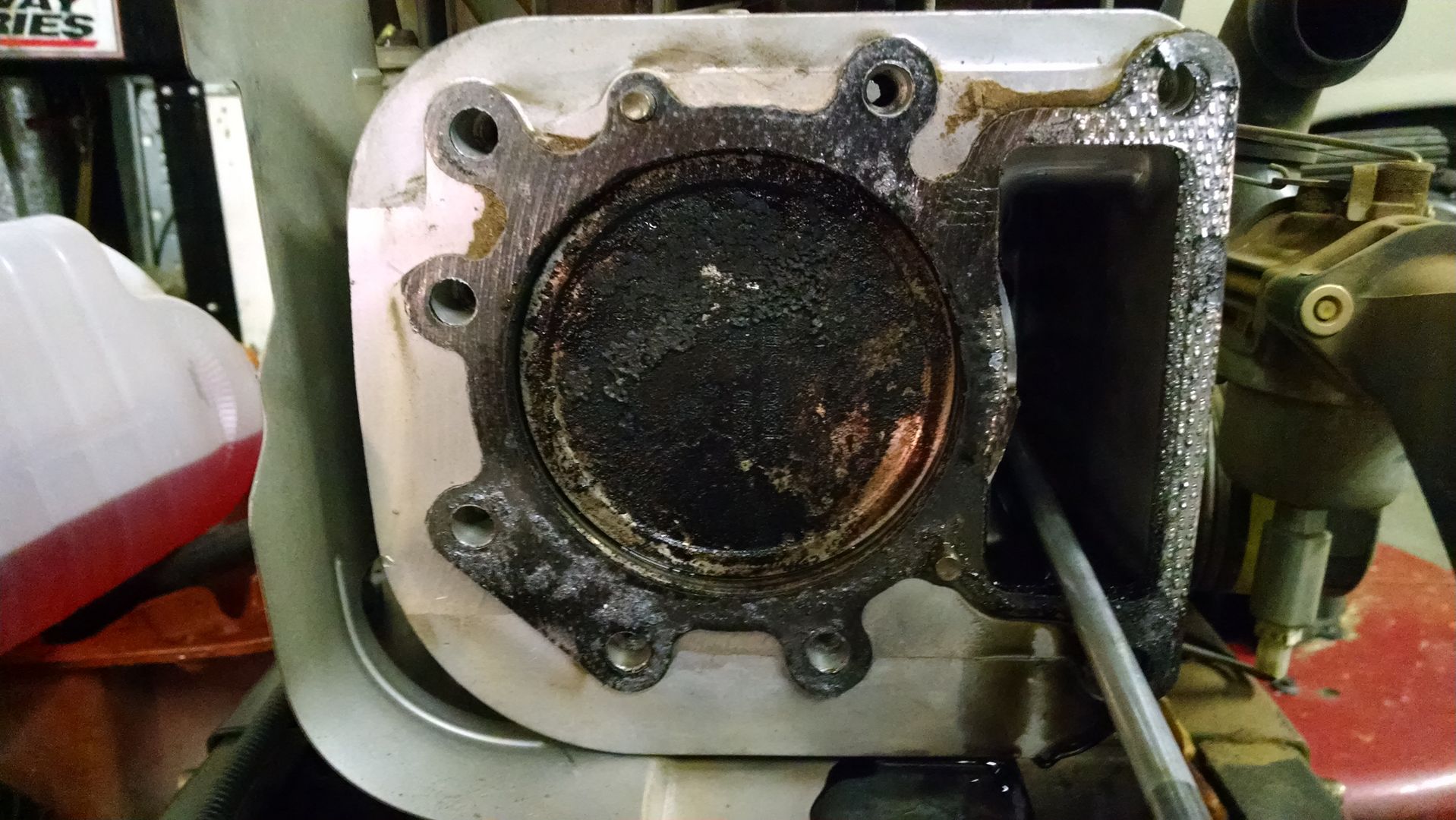
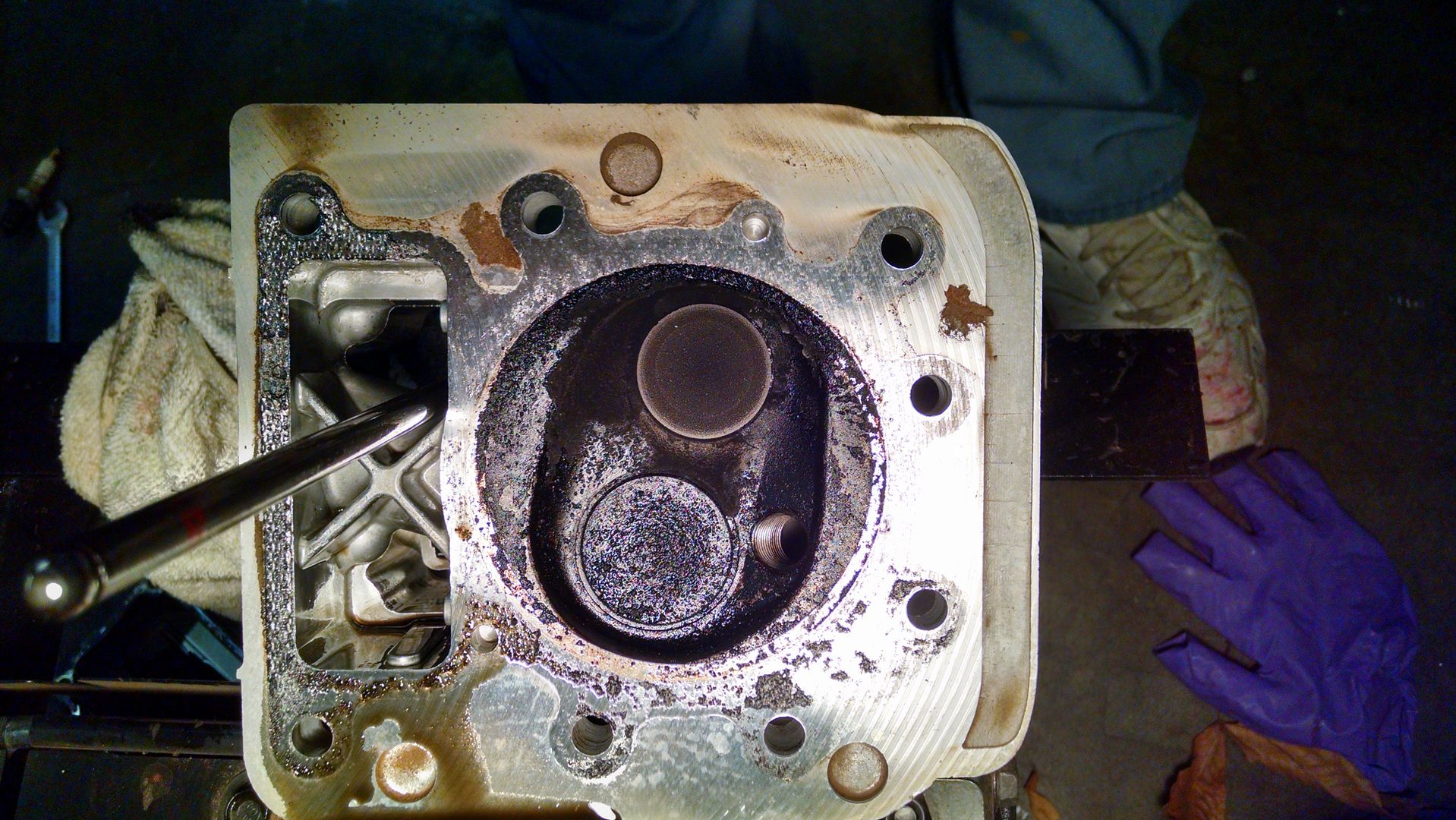
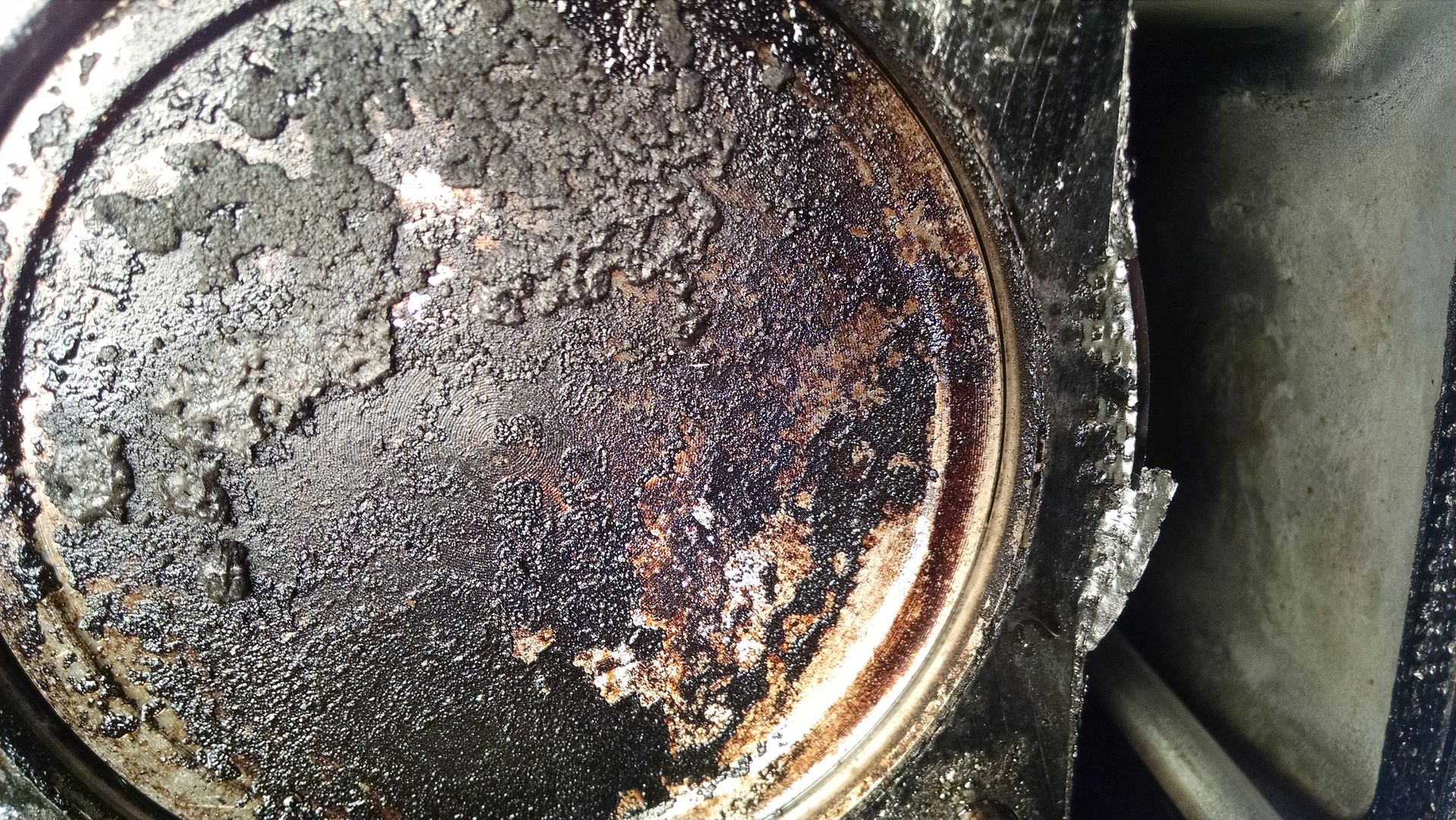
Initially I could not find the break in the gasket facing the cylinder head but after I pulled it off, it appears to have broken in the middle. Of course the break could have been from where I had pulled the gasket off.
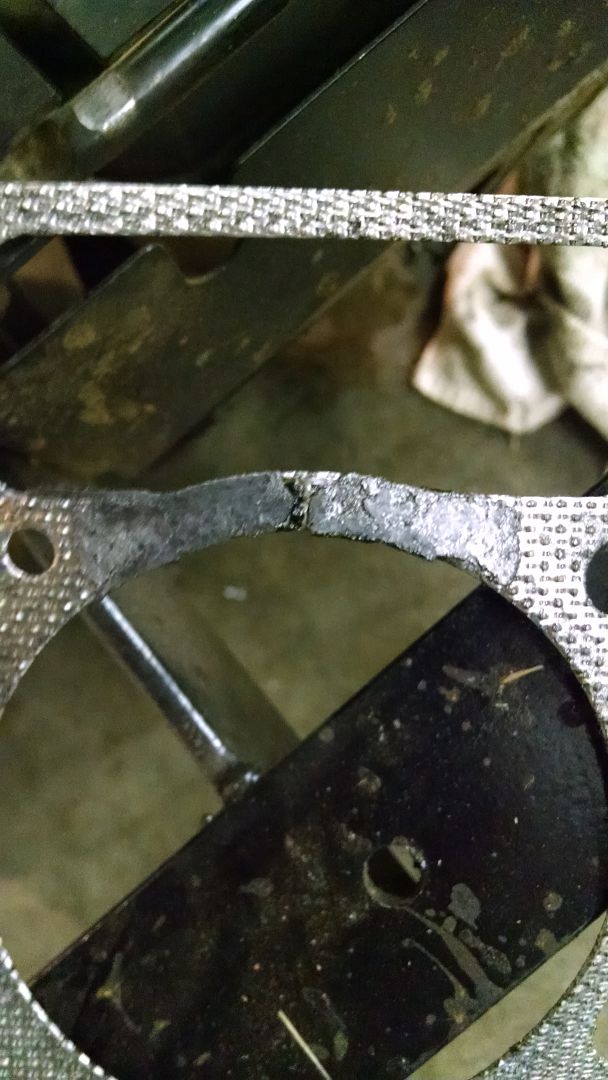 [/URL]
[/URL]
Some carburator cleaner, wire brush and some #0000 fine steel 2 hours later:
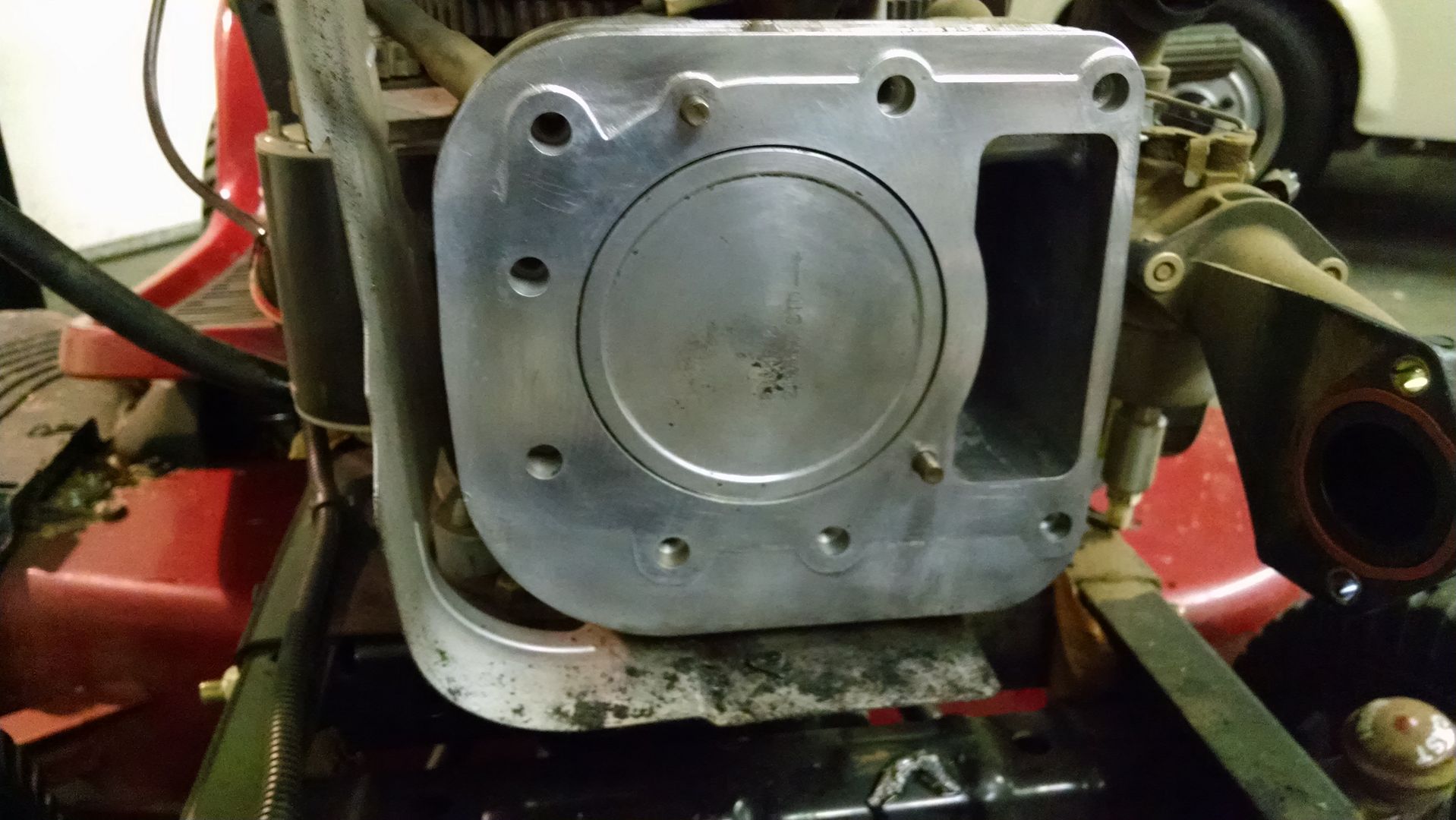
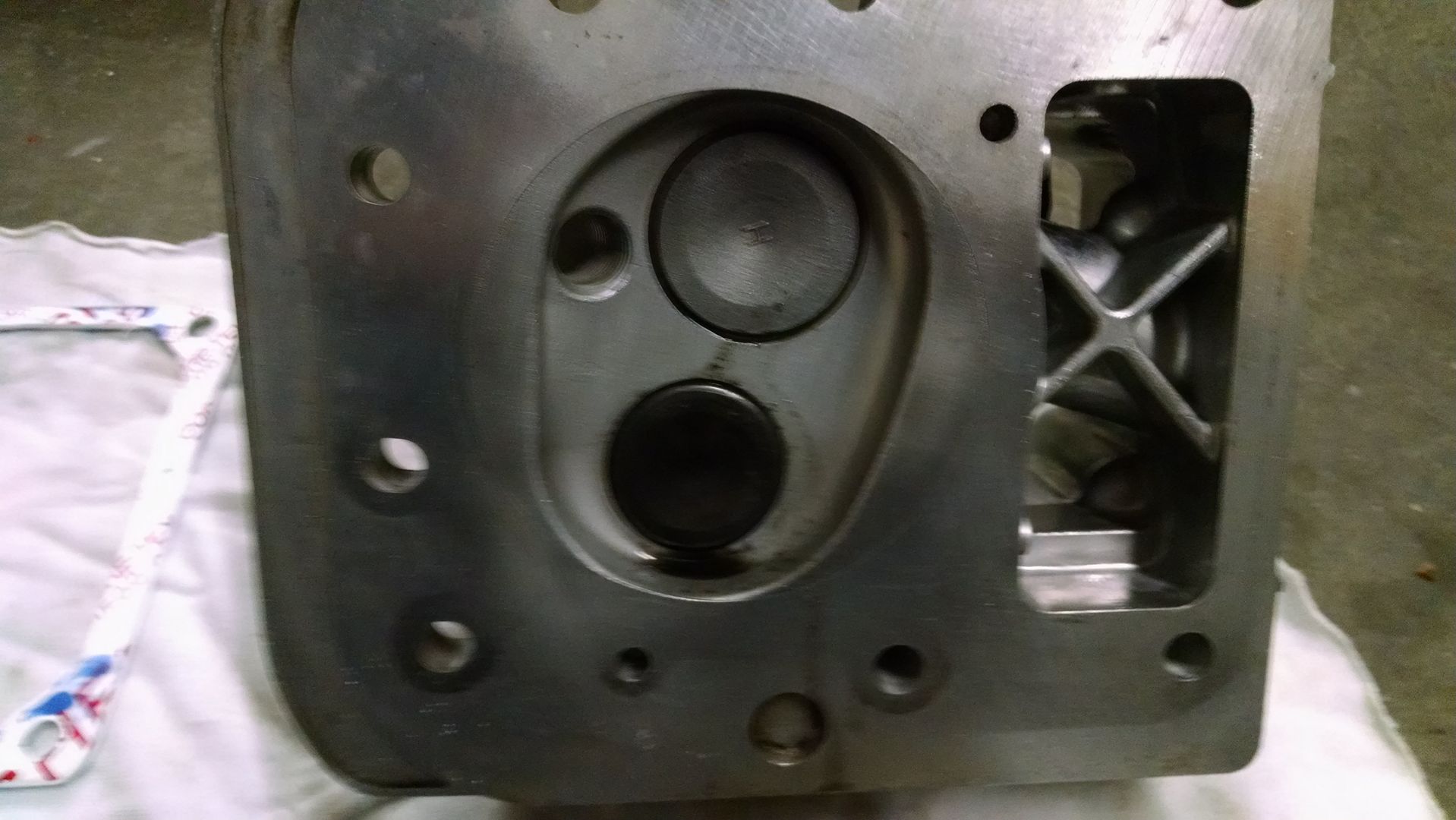
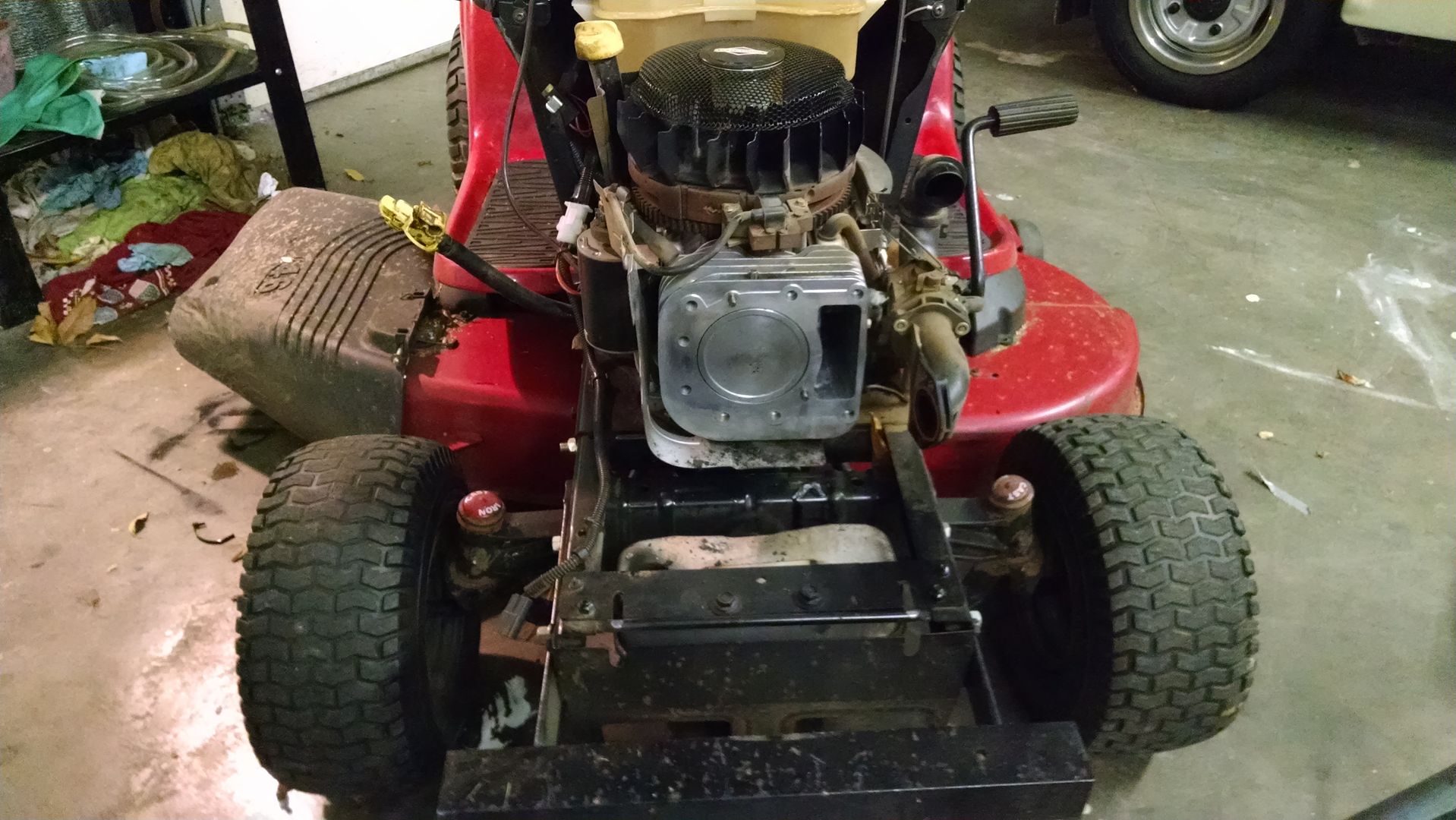
Motor oil, black as tar!
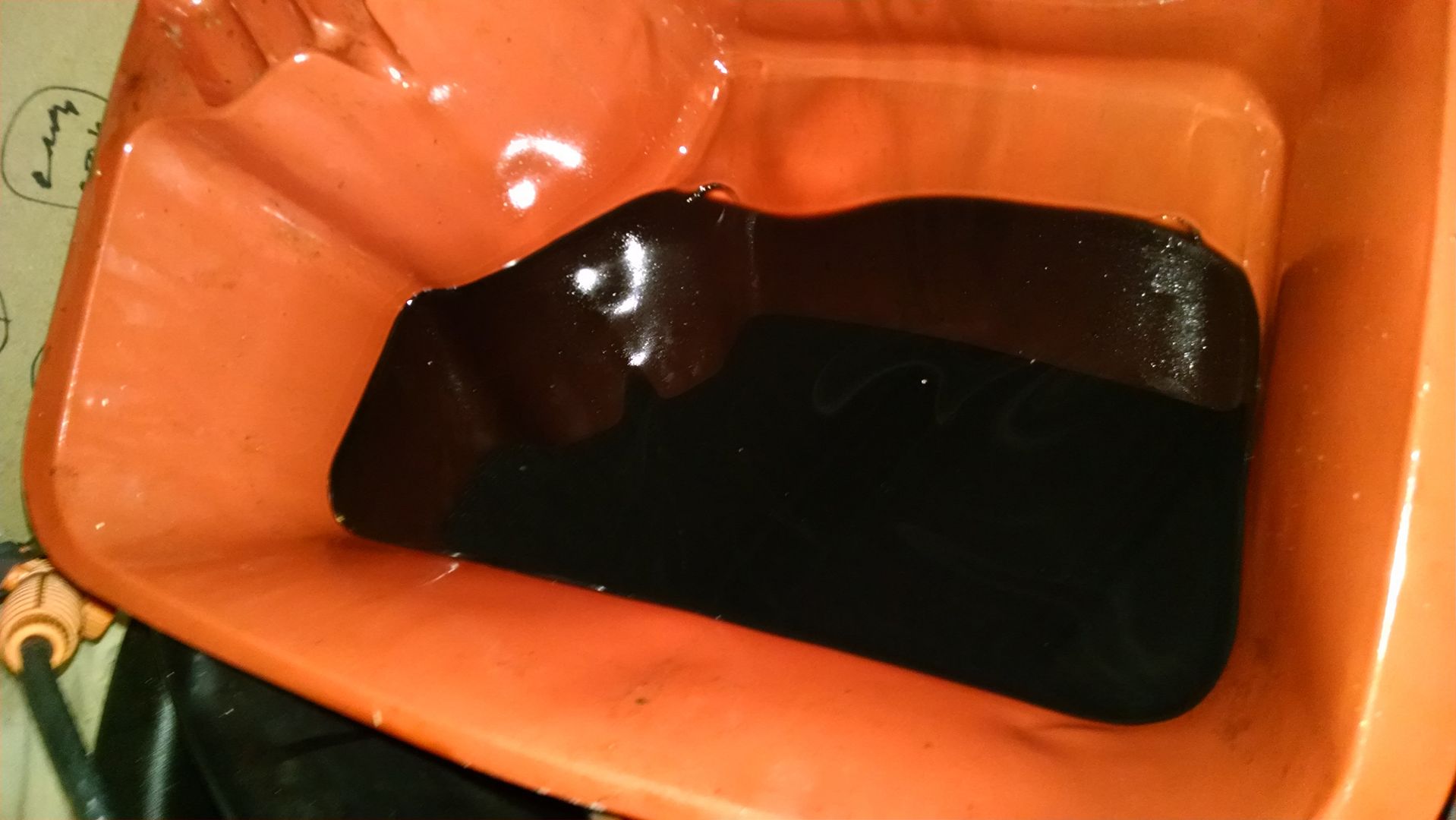 [/URL]
[/URL]
Homemade valve cover gasket made from GoreTex:

Dumb question but there was these little battery looking things in the tray of my parts washer:
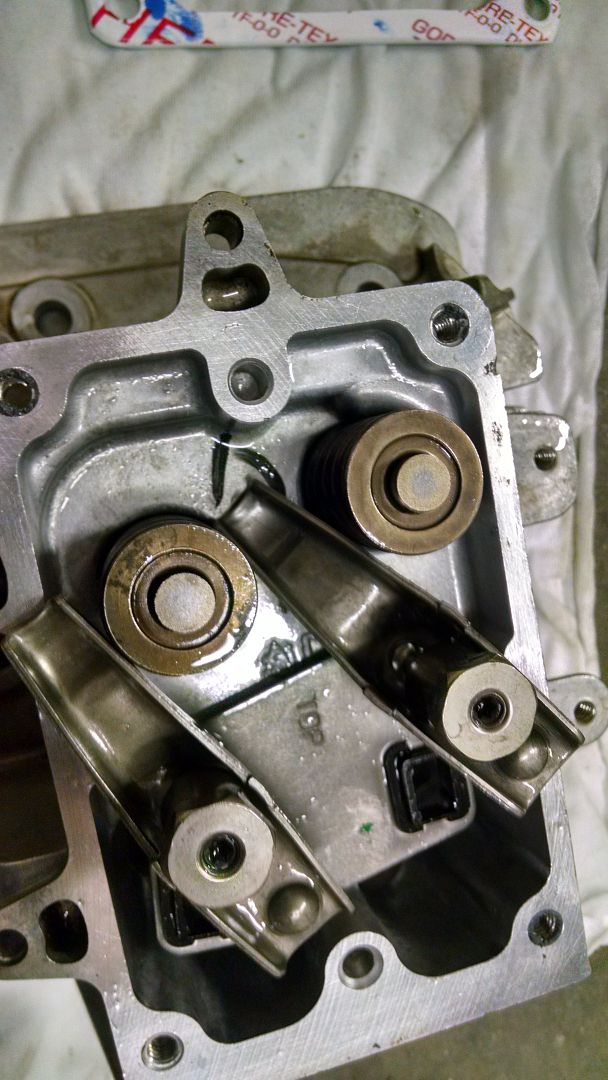 [/URL]
[/URL]
Best I can tell they go on top of the valves. Is that correct?
I printed off the Briggs and Stratton service manual (all 178 pages) at work. HAH!
I painted some reference marks so I know that the engine is 1/4" from TDC before setting the valve clearances. Aluminum push rod= intake, steel = exhaust. 18 ft lbs for the head bolts.
Hopefully I'm good to go once my head gasket arrives.
I probably shouldn't have down this once I noticed it started using oil. I figure I have one more session of mulching and I will be done for the season.
I'm glad I decided to tear it down now because I may have ended up buying a new engine. Based on how black the motor oil was turning just after three hours of use.
Anyway. Big thanks to all that have guided me toward looking at the head gasket before replacing the engine.
So I went ahead and ordered a new head gasket Saturday off Ebay. But it has not shown up as being shipped. So I sent the guy a nastygram asking when he plans on sending me my head gasket because I have already pulled the cylinder head off and cleaned up.
So today I was about and about and decided to see if anybody had this gasket locally so I could get this project wrapped up.
Would you believe all three Briggs parts suppliers in my area did not have this gasket in stock! I would have thought the 21HP Intek would have been a common engine. So I guess I'll just have to wait on my head gasket.
Take a look at the serious carbon buildup!



Initially I could not find the break in the gasket facing the cylinder head but after I pulled it off, it appears to have broken in the middle. Of course the break could have been from where I had pulled the gasket off.

Some carburator cleaner, wire brush and some #0000 fine steel 2 hours later:



Motor oil, black as tar!

Homemade valve cover gasket made from GoreTex:

Dumb question but there was these little battery looking things in the tray of my parts washer:

Best I can tell they go on top of the valves. Is that correct?
I printed off the Briggs and Stratton service manual (all 178 pages) at work. HAH!
I painted some reference marks so I know that the engine is 1/4" from TDC before setting the valve clearances. Aluminum push rod= intake, steel = exhaust. 18 ft lbs for the head bolts.
Hopefully I'm good to go once my head gasket arrives.
I probably shouldn't have down this once I noticed it started using oil. I figure I have one more session of mulching and I will be done for the season.
I'm glad I decided to tear it down now because I may have ended up buying a new engine. Based on how black the motor oil was turning just after three hours of use.
#12
R
Rivets
R
Rivets
First, yes those caps go on the valves, which the rocker arms will hold in place when you set your valve clearances. Second, yes your head gasket was definitely blown. Third, read the manual carefully, have patience, and take your time when reassembling. Finally, nice clean-up job.
#13
B
bertsmobile1
B
bertsmobile1
If you can pull the two dowels out of the block, glue some 400 to 600 wet & dry to a lump of flat glass and dress both the cylinder joining face and the head.
You will find they both are a little hollow between the cylinder & pushrod tunnel where the gasket blew.
If you can not do the block, make sure you do the head or you will be doing this job all over again a lot sooner than you would have liked too.
No head gaskets i stock is very common , they are a vey fast moving item.
I tyr to have 4 of each of the 4 ride on sizes in stock but rarely ar there more than 2 or 3.
They are a very fast moving item.
For 2 of the sizes there is a Stens aftermarket gasket which is a lot better than the B & S original. I rarely have one of these fail.
Jacks keeps the after market gaskets and I strongly recommend you fitting on.
And praise where it belongs, nice job to date.
Put some gasket cement on the rocker cover to glue the gasket in place an some high temperature grease or nickel anti sieze on the other side so the gasket strips off the engine clean.
Makes checking valve lash much easier and you will need to do it a couple of times till the new gasket settles in.
You will find they both are a little hollow between the cylinder & pushrod tunnel where the gasket blew.
If you can not do the block, make sure you do the head or you will be doing this job all over again a lot sooner than you would have liked too.
No head gaskets i stock is very common , they are a vey fast moving item.
I tyr to have 4 of each of the 4 ride on sizes in stock but rarely ar there more than 2 or 3.
They are a very fast moving item.
For 2 of the sizes there is a Stens aftermarket gasket which is a lot better than the B & S original. I rarely have one of these fail.
Jacks keeps the after market gaskets and I strongly recommend you fitting on.
And praise where it belongs, nice job to date.
Put some gasket cement on the rocker cover to glue the gasket in place an some high temperature grease or nickel anti sieze on the other side so the gasket strips off the engine clean.
Makes checking valve lash much easier and you will need to do it a couple of times till the new gasket settles in.
#14

turbofiat124
Thanks for the advice. That probably wouldn't be a bad idea. You can't see it in the photo but I noticed there was some discoloring (slight purple) on the engine block where the gasket blew. Have you ever seen that?
If you notice the blue stuff on my homemade valve cover gasket I made of GoreTex, it's called Steel Ink which can be used to find low spots in surfaces.
Also notice where there is still some carbon on the piston. It's embedded in some pitting in that area. I wonder the pitting that was caused by some detonation from the carbon buildup? Or is this an imperfection in the casting? There was no pitting on the head.

I've actually done something similar with exhaust flanges on turbos. I used a piece of glass and valve lapping compound to resurface a downpipe flange on a T3 turbo.
The guy I bought the gasket from said his internet was down and sent the gasket out today.
turbofiat124
If you can pull the two dowels out of the block, glue some 400 to 600 wet & dry to a lump of flat glass and dress both the cylinder joining face and the head.
You will find they both are a little hollow between the cylinder & pushrod tunnel where the gasket blew.
If you can not do the block, make sure you do the head or you will be doing this job all over again a lot sooner than you would have liked too.
No head gaskets i stock is very common , they are a vey fast moving item.
I tyr to have 4 of each of the 4 ride on sizes in stock but rarely ar there more than 2 or 3.
They are a very fast moving item.
For 2 of the sizes there is a Stens aftermarket gasket which is a lot better than the B & S original. I rarely have one of these fail.
Jacks keeps the after market gaskets and I strongly recommend you fitting on.
And praise where it belongs, nice job to date.
Put some gasket cement on the rocker cover to glue the gasket in place an some high temperature grease or nickel anti sieze on the other side so the gasket strips off the engine clean.
Makes checking valve lash much easier and you will need to do it a couple of times till the new gasket settles in.
Thanks for the advice. That probably wouldn't be a bad idea. You can't see it in the photo but I noticed there was some discoloring (slight purple) on the engine block where the gasket blew. Have you ever seen that?
If you notice the blue stuff on my homemade valve cover gasket I made of GoreTex, it's called Steel Ink which can be used to find low spots in surfaces.
Also notice where there is still some carbon on the piston. It's embedded in some pitting in that area. I wonder the pitting that was caused by some detonation from the carbon buildup? Or is this an imperfection in the casting? There was no pitting on the head.

I've actually done something similar with exhaust flanges on turbos. I used a piece of glass and valve lapping compound to resurface a downpipe flange on a T3 turbo.
The guy I bought the gasket from said his internet was down and sent the gasket out today.
#15
B
bertsmobile1
B
bertsmobile1
Yes there is always some damage to both he head & barrel.
Mostly on the head.
Depends just how long the owner has been using it like that.
Some I have done would have been using almost as much oil as fuel and more than one neighbour has come out with some advice on what the owner should do with that Bloo? smokey mower.
Mostly on the head.
Depends just how long the owner has been using it like that.
Some I have done would have been using almost as much oil as fuel and more than one neighbour has come out with some advice on what the owner should do with that Bloo? smokey mower.
#16

turbofiat124
turbofiat124
I had a detailed update with photos written out (took me 30 minutes) but now it's gone or I hit preview instead of post. :frown:
I don't feel like retying my post it at the moment but the jest of it is, I resurfaced the head, valves adjusted and it fired right up and no blue smoke.
My main question was concerning the head shield that surrounds the fins on the cylinder head. It's held on by a small bolt with a 5/16" head. Before I removed it (to resurface the block) it seemed stationary but now I can sort of move it around and think it might vibrate or rattle. I'm afraid to tighten it more for fear of braking the bolt off.
Does this shield aid in cooling or is it just a heat shield to prevent thermal burns? in other words if it starts to make a racket, I'd just soon remove it but if it's there to aid to cooling, then why is it moving around? Looks like it should have more than one fastener hold it in place.
I don't feel like retying my post it at the moment but the jest of it is, I resurfaced the head, valves adjusted and it fired right up and no blue smoke.
My main question was concerning the head shield that surrounds the fins on the cylinder head. It's held on by a small bolt with a 5/16" head. Before I removed it (to resurface the block) it seemed stationary but now I can sort of move it around and think it might vibrate or rattle. I'm afraid to tighten it more for fear of braking the bolt off.
Does this shield aid in cooling or is it just a heat shield to prevent thermal burns? in other words if it starts to make a racket, I'd just soon remove it but if it's there to aid to cooling, then why is it moving around? Looks like it should have more than one fastener hold it in place.
#17
B
bertsmobile1
B
bertsmobile1
It is essential, don't even think about leaving it off.
Clean out the bolt hole and ou might need to run a tap down it to clean up the thread.
The air baffles are not particularly tight and locate onto the top cover,
If it worries you slip a small O ring under the head of the bolt to take up the slack.
Remember it all gets quite hot and there has to be expansion space.
Clean out the bolt hole and ou might need to run a tap down it to clean up the thread.
The air baffles are not particularly tight and locate onto the top cover,
If it worries you slip a small O ring under the head of the bolt to take up the slack.
Remember it all gets quite hot and there has to be expansion space.
#18

turbofiat124
I was thinking the shield clipped onto the engine block somewhere but can't seem to find a location where I might. So does the shield just "dangle" using one bolt?
What I meant earlier but was a lose for words was I can rotate the shield a bit from side to side.
Here is the shield in question:
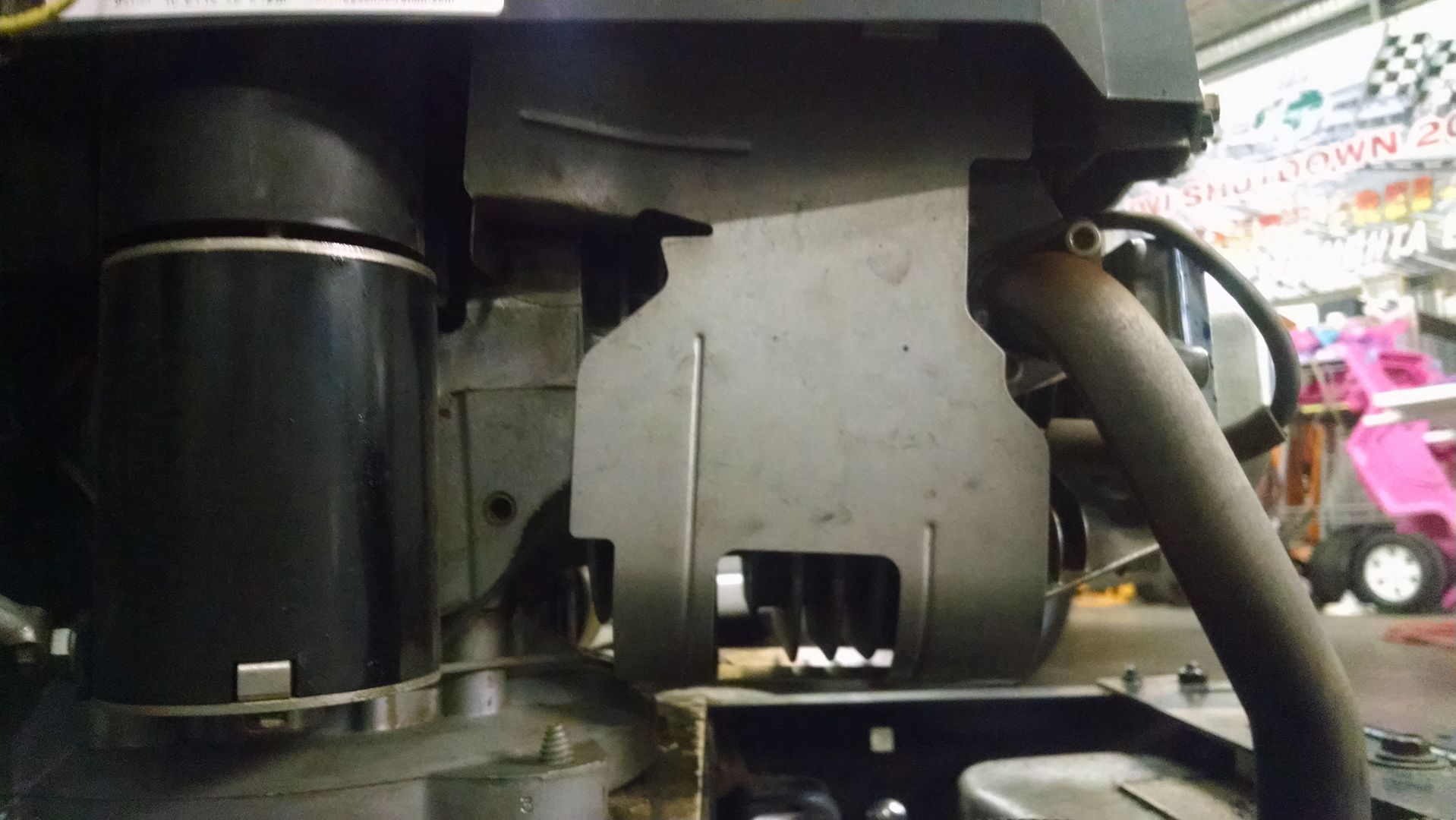
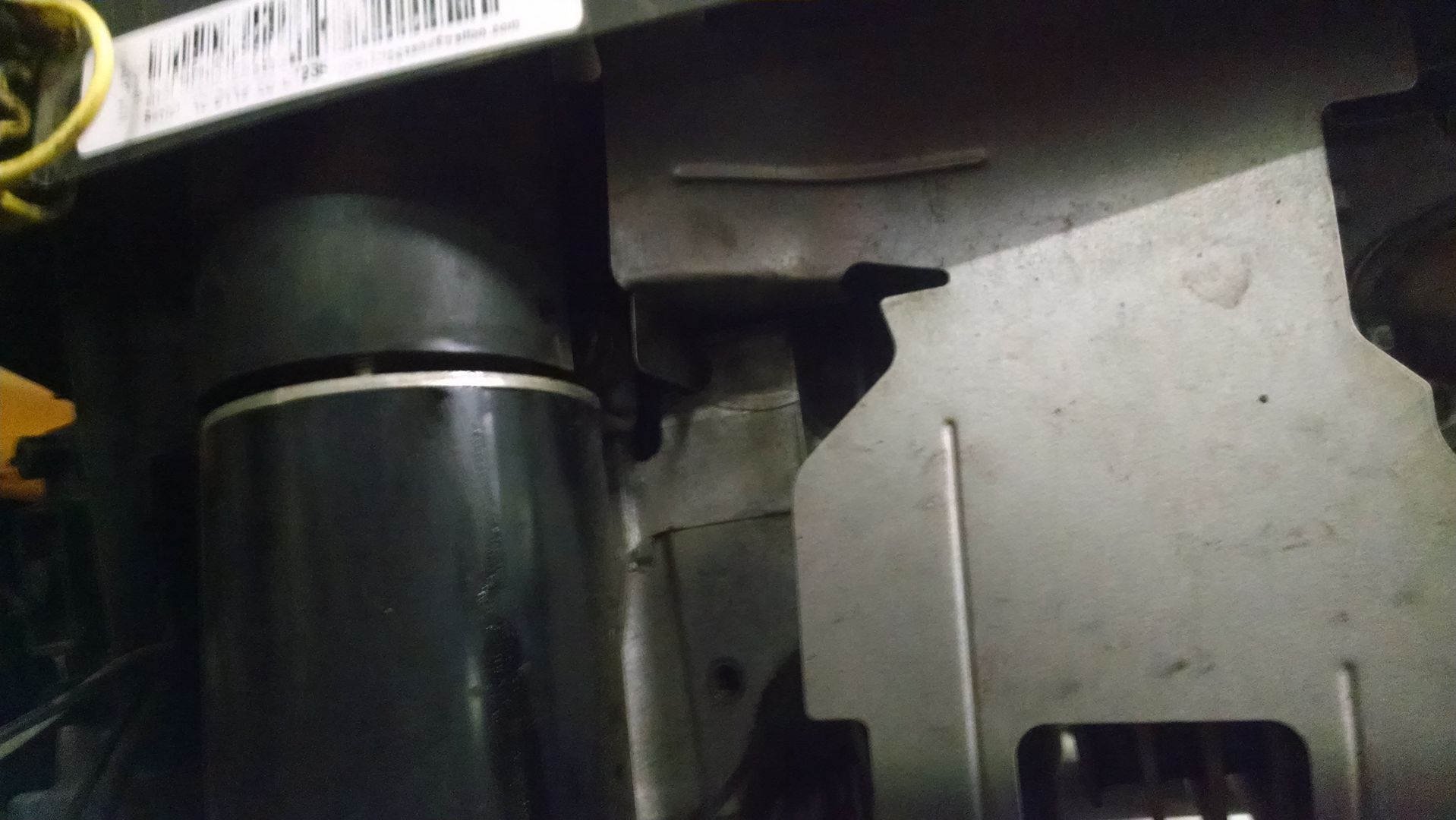
Notice there is a bend near the starter. It appears this bend should pop in place against the block so to speak. If that make sense.
I thought I might have left a shield off the engine but it is nowhere to be found in my garage and I piled everything up together so nothing would get lost.
I was trying to figure out if I left a shield off the engine. There are a couple of threaded holes in the head but I have no leftover fasteners.
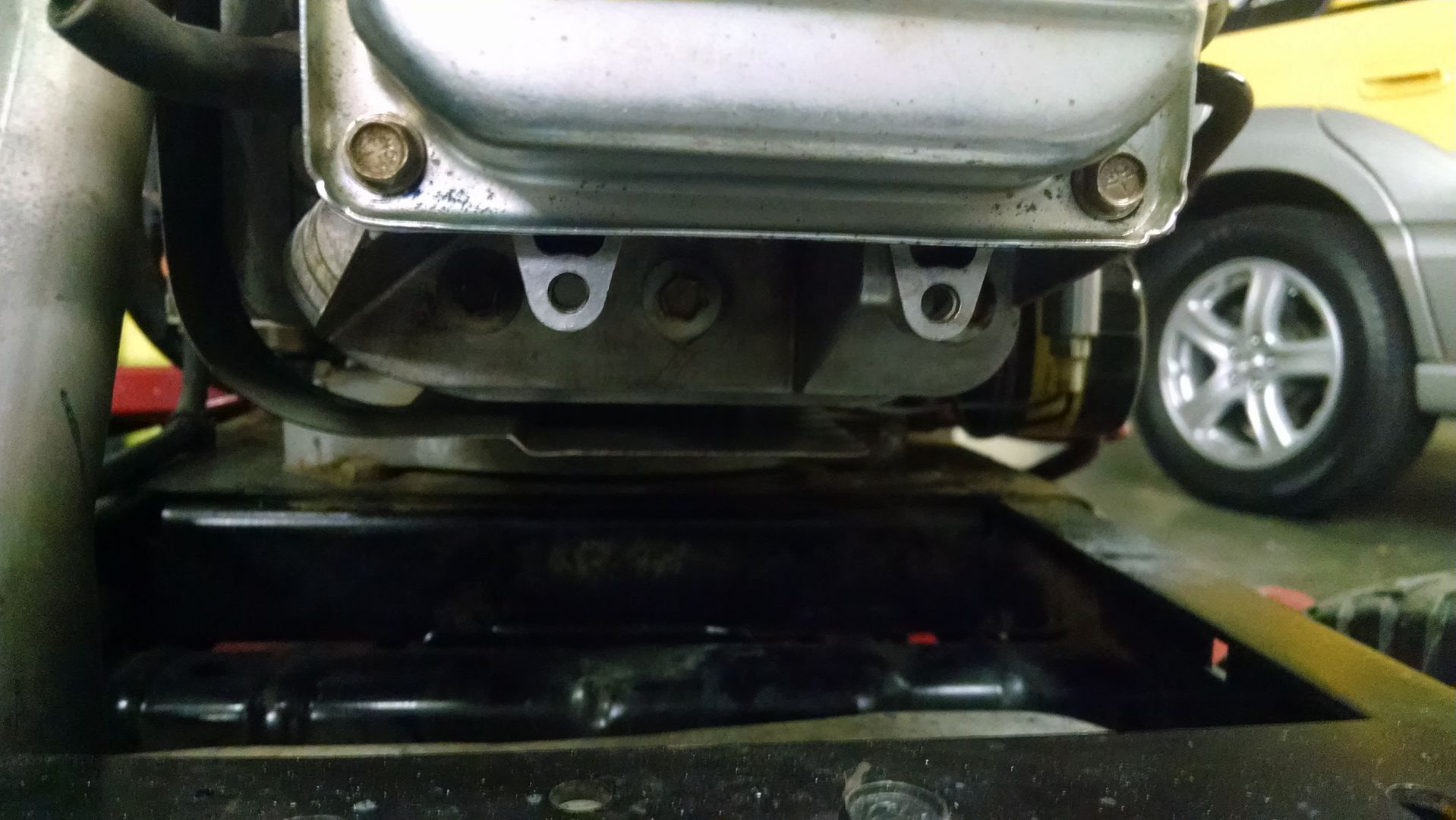
turbofiat124
It is essential, don't even think about leaving it off.
Clean out the bolt hole and ou might need to run a tap down it to clean up the thread.
The air baffles are not particularly tight and locate onto the top cover,
If it worries you slip a small O ring under the head of the bolt to take up the slack.
Remember it all gets quite hot and there has to be expansion space.
I was thinking the shield clipped onto the engine block somewhere but can't seem to find a location where I might. So does the shield just "dangle" using one bolt?
What I meant earlier but was a lose for words was I can rotate the shield a bit from side to side.
Here is the shield in question:


Notice there is a bend near the starter. It appears this bend should pop in place against the block so to speak. If that make sense.
I thought I might have left a shield off the engine but it is nowhere to be found in my garage and I piled everything up together so nothing would get lost.
I was trying to figure out if I left a shield off the engine. There are a couple of threaded holes in the head but I have no leftover fasteners.

#19

ILENGINE
ILENGINE
The top of that heat shield is held in place by the blower housing. The offset notch sides onto the blower housing.
#20
M
motoman
M
motoman
I do believe Briggs has (had) a quality problem. In my case the Intek 24 failed with a pushed valve guide in year 2 from new after very careful use on 5 acres. To this day no one has explained why this happens . I believe it may be a combination of things. With oil pressure and oil temperature gauges installed after the failure I have monitored this engine since I disassembled it. The assembly clearances (fit) for the guide to head were ok. You cannot buy a guide for replacement which tells me Briggs knows they have a recurrent problem (and so do others).
I have installed a temp probe and have seen cylinder head temp of 305F. I could not drive it higher in summer under load, but could not measure the guide area exactly. It is possible that excessive heat softens the aluminum alloy which loosens its grip on the guides. It is not Briggs who does the system design. I believe the 3 bag system loaded with damp grass and operating on grades in summer pushes the Briggs oil temp above 300F which will not in itself cause failure but which inhibits overall cooling. Although I still use the bagger, a better idea is a sweeper. Also Briggs furnished a replacement head which has not been a problem and the other head has never acted up. Briggs depends upon receiving alloy heads with a certain composition and without inclusions, etc. At the price point Briggs is probably accepting paper certs and not doing any characteriztion of the received head material. I have the failed head and have been tempted to have the head Brinell tested (softness), but no enthusiasm in the forum. My 2004 DYT 4000 is still running well although I feel a little trans slip in cold weather . Don't know the hours 'cause the meter went away long ago. Oil pressure hot is about 35 psi.. I am using 5W-30 Mobil 1 only because wife's fancy car uses it.
BTW I hope you know you cannot simply replace rings like a person does with a sink washer, or you will be taking it apart again. Right gang?:2cents:
I have installed a temp probe and have seen cylinder head temp of 305F. I could not drive it higher in summer under load, but could not measure the guide area exactly. It is possible that excessive heat softens the aluminum alloy which loosens its grip on the guides. It is not Briggs who does the system design. I believe the 3 bag system loaded with damp grass and operating on grades in summer pushes the Briggs oil temp above 300F which will not in itself cause failure but which inhibits overall cooling. Although I still use the bagger, a better idea is a sweeper. Also Briggs furnished a replacement head which has not been a problem and the other head has never acted up. Briggs depends upon receiving alloy heads with a certain composition and without inclusions, etc. At the price point Briggs is probably accepting paper certs and not doing any characteriztion of the received head material. I have the failed head and have been tempted to have the head Brinell tested (softness), but no enthusiasm in the forum. My 2004 DYT 4000 is still running well although I feel a little trans slip in cold weather . Don't know the hours 'cause the meter went away long ago. Oil pressure hot is about 35 psi.. I am using 5W-30 Mobil 1 only because wife's fancy car uses it.
BTW I hope you know you cannot simply replace rings like a person does with a sink washer, or you will be taking it apart again. Right gang?:2cents:
#21

turbofiat124
turbofiat124
Sorry for the late reply guys. I put the head back on my engine and adjusted the valve clearances to spec (.003"), I guess that's close enough. It fired right up, maybe faster than before.
I managed to mow about an acre or two during the first week of December. My wife said the rest of the yard did not need mulching so I gave up on the rest of the yard and parked it in my yard barn. I have not monitored the oil consumption but the engine never smoked.
So I'm going to assume the head gasket replacement was a success. I've replaced more than a couple of headgaskets on "old school" Fiat engines but never an OHC lawnmower engine.
If this engine fails or blows up, I'm replacing it with a Kohler engine like I did with my Snapper Hi-Vac mower. The same mower that the original B&S threw a rod through the blow when the connecting rod nuts vibrated loose.
Kohler engines seem to be bulletproof.
I managed to mow about an acre or two during the first week of December. My wife said the rest of the yard did not need mulching so I gave up on the rest of the yard and parked it in my yard barn. I have not monitored the oil consumption but the engine never smoked.
So I'm going to assume the head gasket replacement was a success. I've replaced more than a couple of headgaskets on "old school" Fiat engines but never an OHC lawnmower engine.
If this engine fails or blows up, I'm replacing it with a Kohler engine like I did with my Snapper Hi-Vac mower. The same mower that the original B&S threw a rod through the blow when the connecting rod nuts vibrated loose.
Kohler engines seem to be bulletproof.
#22
S
slapshot
S
slapshot
I always thought the Kohlers were great but I have been reading about the "Courage" series being a problem with cracked blocks.
#23

ILENGINE
That was the single cylinder version and was the result of the cover bolts either not torqued properly or coming loose.
ILENGINE
I always thought the Kohlers were great but I have been reading about the "Courage" series being a problem with cracked blocks.
That was the single cylinder version and was the result of the cover bolts either not torqued properly or coming loose.
#24
B
bertsmobile1
Because the cast mallable iron crank was too heavy for the crankcases designed for a forged steel crank that was 1/2 the weight.
Price you have to pay if you are not willing to pay the price for quality.
B
bertsmobile1
That was the single cylinder version and was the result of the cover bolts either not torqued properly or coming loose.
Because the cast mallable iron crank was too heavy for the crankcases designed for a forged steel crank that was 1/2 the weight.
Price you have to pay if you are not willing to pay the price for quality.
